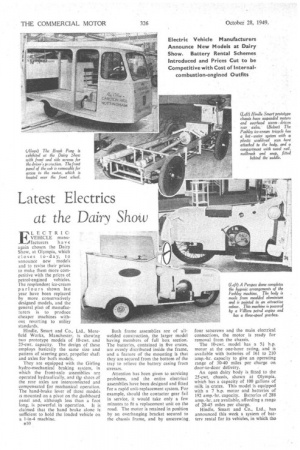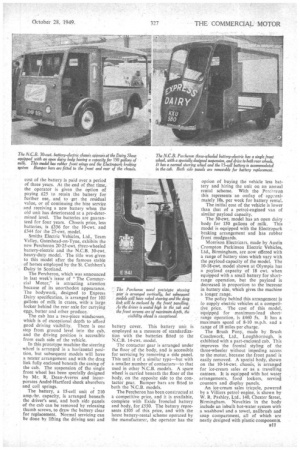Latest Electrics
Page 44

Page 45

If you've noticed an error in this article please click here to report it so we can fix it.
at the Dairy Show ULECTRIC. VEHICLE manu 1 14facturers have again chosen the Dairy Show, at Olympia, which closes to-day, to announce new models and to revise their prices to make them more competitive with the prEces of petrol-engincd vehicles. The resplendent ice-cream parlours shown last year have been replaced by more conservatively designed models, and the general plan of manufacturers is to produce cheaper machines without resorting to utility standards.
Hindle, Smart and Co., Ltd., Merefield Works, Manchester, is showing two prototype models of 10-cwt. and 25-cwt. capacity. The design of these employs basically the same size and pattern of steering gear, propeller shaft and axles for both models.
They are equipped with the Girling hydro-mechanical braking system, in which the front-axle assemblies are operated hydraulically, and ttle shoes of the rear axles are interconnected and compensated for mechanical operation. The hand-brake lever of these models is mounted on a pivot on the dashboard panel and, although less than a foot long, is powerful in operation. It is claimed that the hand brake alone is sufficient to hold the loaded vehicle on a 1-in-4 machine. Both frame assemblies are of allwelded construction, the larger model having members of full box section. The batteries, contained in five crates, are evenly distributed inside the frame, and a feature of the mounting is that they are secured from the bottom of the tray to relieve the battery casing from stresses.
Attention has been given to servicing problems, and the entire electrical assemblies have been designed and fitted for a rapid unit-replacement system. For example, should the contactor gear fail in service, it would take only a few minutes to fit a replacement unit on the road. The motor is retained in position by an overhanging bracket secured to the chassis frame, and by unscrewing, four setscrews and the main electrical connections, the motor is ready for removal from the chassis.
The 10-cwt. model has a 51 h.p. motor at the one-hour rating, and is available with batteries of 161 to 210 amp.-hr. capacity to give an operating range of 30-40 miles per charge on door-to-door delivery.
An open dairy body is fitted to the 25-cwt. chassis, shown at Olympia, which has a capacity of 100 gallons of milk in crates. This model is equipped with a 7 h.p. motor and batteries of 192 amp.-hr. capacity. Batteries of 288 amp.-hr. are available, affording a range of 28-45 miles per charge.
Hindle, Smart and Co., Ltd., has announced this week a system of battery rental for its vehicles, in which the cost of the battery is paid over a period of three years. At the end of that time, the operator is given the option of paying £25 to retain the battery for further use, and to get the residual value, or of continuing the hire service arid receiving a new battery when the old unit has deteriorated at a pre-determined level. The batteries are guaranteed for four years. Chassis price, less batteries, is £336 for the 10-cwt. and £344 for the 25-cwt. model.
Smiths Electric Vehicles, Ltd., Team Valley, Gateshead-on-Tyne, exhibits the new Percheron 20-25-cwt. three-wheeled battery-electric and the N.C.B. 30-cwt. heavy-duty model. The title was given to this model after the famous stable of horses employed by the St. Cuthbert's Dairy in Scotland.
The Percheron, which was announced in last week's issue of "The Commercial Motor," is attracting attention because of its unorthodox appearance. The bodywork, designed to Express Dairy specification, is arranged for 100 gallons of milk in crates, with a large locker behind the rear axle -for carrying eggs, butter and other produce.
The cab has a two-piece windscreen, which is of exceptional depth to afford good driving visibility. There is one step from ground level into the cab, and the driving position is accessible from each side of the vehicle.
In this prototype machine the steering wheel is arranged in a horizontal position, but subsequent models will have a neater arrangement and with the drag link fulLy enclosed beneath the casing of the cab. The suspension of the single front wheel has been specially designed by Mr. R. Dean-Averns and incorporates Andre-Hartford shock absorbers and coil springs.
The battery, a 15-cell unit of 210 amp.-hr. capacity, is arranged beneath the driver's seat, and both side panels of the cab can be removed by releasing thumb screws, to draw the battery clear for replacement. Normal servicing can be done by lifting the driving seat and
battery cover. This battery unit is employed as a measure of standardization with the batteries fitted to the N.C.B. 14-cwt. model.
The contactor gear is arranged under the floor .of the body, and is accessible for servicing by removing a side panel. This unit is of a similar type—but with a smaller number of contactors—to that used in other N.C.B. models. A spare wheel is carried beneath the floor of the body, on the opposite side to the contactor gear. Bumper bars are fitted to both the N.C.B. models.
The Percheron has been constructed at a competitive price, and it is available, complete with Exide Ironclad battery and body. for £550. The battery represents £105 of this price, and with the latest battery-rental scheme operated by the manufacturer, the operator has the
option of buying the vehicle less battery and hiring the unit on an annual rental scheme. With the Pereileron this represents an outlay of approximately 10s. per week for battery rental.
The initial cost of the vehicle is lower than that of a petrol-engined van of similar payload capacity.
The 30-cwt. model has an open dairy body for 150 gallons of milk. This model is equipped with the Electropark braking arrangement and has rubber front mudguards.
Morrison Electricars, made by Austin Crompton Parkinson Electric Vehicles, Ltd., Birmingham, are now offered with a range of battery sizes which vary with the payload capacity of the model, The 10-18-cwt. model shown at Olympia has a payload capacity of 18 cwt. when equipped with a small battery for shortrange operation, but the payload is decreased in proportion •to the increase in battery size, which gives the machine a longer range.
The policy behind this arrangement is to supply electric vehicles at a competitive price. The cost of this model, equipped for maximum-load shortrange operation, is £460 5s. It has a maximum speed of 8-10 m.p.h. and a range of 18 miles per charge.
The Brush Pony, made by Brush Coachwork, Ltd., Loughborough, is exhibited with a part-enclosed cab. This improves the frontal styling of the three-wheeler without impeding access to the motor, because the front panel is easily removed. A special body, shown on the 10-14-cwt, chassis, is arranged for ice-cream sales or as a travelling canteen. It is equipped with hot water arrangements, food lockers, serving counters and display panels.
An ice-cream sales tricycle, powered by a Villiers petrol-engine, is shown by W. R. Pashley, Ltd„ 140, Chester Street, Birmingham. Novelties in the body include an inbuilt hot-water system with a washbowl and a towel, nailbrush and soap compartment, all of which are neatly designed with plastic components.




























































































